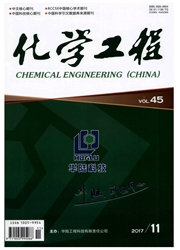

 中文摘要:
中文摘要:
以蒸汽、水为实验介质,研究气流床煤气化系统的关键设备之一——固阀板式热水塔的传热特性.利用塔板上汽液二相逆流热质传递过程能量方程,根据实验结果拟合出了预测传热效率的公式,并通过改变开孔率、孔径、阀高和孔间距等固阀塔板结构参数研究其对传热特性的影响.实验结果表明:传热效率预测值与实验值相符程度较高,验证了公式能较好地描述热水塔内蒸汽-水一元体系直接接触冷凝传热过程;传热效率随着传热单元数的增加而增加,在液汽比(质量比)为5-32实验操作范围内,传热效率一般低于55%;当传热效率较低时可以通过减小动能因子,增大传热单元数,从而提高传热效率;当传热效率较高时,可以适当减小开孔率、孔径和阀高,增加传热面积,提高传热效率,而孔间距对传热效率的影响可以忽略不计.
 英文摘要:
英文摘要:
Based on steam and water as experimental medium, the heat transfer characteristics of fixed-valve plate hot water tower were studied, which was one of the key equipment of entrained-flow coal gasification system. The tray heat transfer efficiency was reviewed, and a mathematical model with energy transfer equation to predict the details of the heat and mass transfer process was proposed in a hot water tower. The relationships between heat transfer efficiency and measured parameters were found to predict the direct-contact condensation model on downcommerless trays. Furthermore, the tray geometry parameters of hole areas, hole diameter, valve height and hole center distance were investigated in the heat transfer process. The experimental results indicate that the influence of operating parameters on the heat efficiency is demonstrated for different operating conditions. The gas flow rate, liquid flow rate and tray parameters have considerable effects on heat efficiency. The heat transfer efficiency gets enhanced with the increase of heat transfer units NTU, but it is consistently lower than 55%. When the heat transfer efficiency is low, it can get increased through reducing the kinetic energy factor and increasing the heat transfer unit number. However, when it is high, it can only be increased by reducing the hole area, valve height and hole diameter. The influence of hole center distance on the heat efficiency can be negligible.
 同期刊论文项目
同期刊论文项目
 同项目期刊论文
同项目期刊论文
 期刊信息
期刊信息
